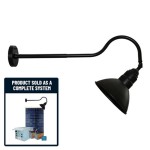How to Extend Outdoor Cable
Extending outdoor cable is a common task for homeowners and DIY enthusiasts alike. Whether you're adding a new outdoor outlet, connecting a security camera, or expanding your Wi-Fi network, understanding how to properly extend cable outdoors is crucial for a reliable and safe installation. This article will guide you through the process of extending outdoor cable, providing essential information and tips to ensure a successful outcome.
Choosing the Right Cable
The first step in extending outdoor cable is selecting the appropriate cable type. Outdoor cables are designed to withstand harsh weather conditions, including rain, snow, and extreme temperatures. Here are some common types of outdoor cables and their applications:
- Coaxial Cable: Used for cable TV and internet connections. Look for cables with a weatherproof jacket.
- Ethernet Cable: Used for high-speed internet connections and network devices. Choose outdoor-rated Ethernet cables with a durable outer sheath.
- Speaker Wire: Use outdoor speaker wire for connecting outdoor speakers to your home audio system.
- Telephone Cable: Choose outdoor-rated telephone cable for connecting outdoor phone lines.
It's essential to select a cable with the correct gauge and shielding for the intended application. Consult the manufacturer specifications or consult with a professional to ensure you choose the right cable for your needs.
Installing the Extension
Once you've chosen the right cable, it's time to install the extension. Here are some key steps to follow:
1. Plan the Route
Before you start, carefully plan the route of the cable. This will minimize the amount of cable needed and ensure it's installed in a safe and unobtrusive manner. Consider these factors:
- Distance: Determine the distance between the existing cable and the new device or location you're connecting.
- Obstacles: Identify any potential obstacles, such as trees, fences, or walls, and plan a path that avoids them.
- Aesthetics: Consider the visual impact of the cable and choose a route that blends in with the surroundings.
2. Prepare the Cable
Prepare the cable for extension by stripping off the outer sheath and exposing the inner conductors. Be careful not to cut or damage the wires. Use a cable stripper designed for the specific cable type you're working with.
3. Connect the Cable
Use appropriate connectors to connect the extended cable to the existing cable and the new device. For example, you might use F-type connectors for coaxial cable, RJ-45 connectors for Ethernet cable, or banana plugs for speaker wire.
Ensure the connections are secure and properly insulated to prevent shorts or electrical hazards.
Protecting the Cable
Once the cable is installed, it's essential to protect it from the elements and potential damage.
1. Cable Protection
Consider using cable protectors or conduit to shield the cable from harsh weather conditions and physical damage. Cable protectors come in various materials, such as plastic or metal, and can be buried underground or attached to walls or fences.
2. Cable Ties
Use cable ties or zip ties to secure the cable to surfaces to prevent it from dangling loose and becoming a tripping hazard. Ensure the ties are placed securely but do not overtighten, as this could damage the cable.
3. Cable Covers
For more exposed locations, use cable covers or raceways to conceal the cable and improve its aesthetic appeal. These covers are available in various colors and materials to match your home's exterior.
Troubleshooting and Safety
After completing the extension, test the connection to ensure it's working correctly. If you encounter any problems, troubleshoot the connection by checking the following:
- Cable Connections: Ensure all connections are secure and properly insulated.
- Cable Damage: Inspect the cable for any signs of damage or wear.
- Device Compatibility: Verify that the devices you are connecting are compatible.
Always prioritize safety when working with electrical wiring. If you are unsure about any aspect of the installation, it's best to consult with a licensed electrician.
By following these tips and steps, you can successfully extend outdoor cable and improve your home's functionality and connectivity.

How To Extend An Exterior Electrical Granworks
:strip_icc()/SCW_262_04-bbae388b0b21470aba12b4366a1544a6.jpg?strip=all)
How To Extend Power Outdoors

Antenna Cable How To Choose Or Extend For The Outdoor Ap Wap 6000 7000 Map 2000 2000r Faq Planet Technology

What S The Best Way To Run Power Outside Mr Electric

Outdoor Extension Cord Safety Tips

The 5 Best Extension Cords For Your Home And Garage Of 2024 Reviews By Wirecutter

Outdoor Electrical Cable A Free All Inclusive

Extend Cable For Antenna Outdoor 4g 5g

How To Safely Use Extension Cords Outside Fusion Electric

Uniden Cellular Booster Outdoor Cable Extension Bundle 50 Feet 15m Ca
Related Posts







